Drawings based on the gem
Once in the Marlborough collection, the gem was often redrawn: Giovanni Battista Cipriani painted a version of the gem, [12] Francesco Bartolozzi engraved it, James Tassie cast it in opaque coloured glass paste, [13] and for Josiah Wedgwood, first William Hackwood reproduced a low relief from Tassie's cast, and then John Flaxman modeled it at a larger scale; [14] both versions were executed in Wedgwood & Bentley's white-on-blue jasperware that imitated cameos; the "Marlborough gem" first appeared in Wedgwood's 1779 catalogue. The Wedgwood plaque, available in several sizes, appears mounted on Parisian and London furniture, and a marble relief of the scene is set in the chimneypiece of the red drawing room at the original home of the Marlborough gems. [15]
It became so familiar that the caricaturist James Gillray engraved a parody of it in 1797, lampooning the long-delayed marriage of Lord Derby to the actress Elizabeth Farren, who is travestied as a tall, lanky veiled figure, who is offered a countess's coronet instead of the winnowing fan of pomegranates, with the plump cherubic Lord Derby at her side. By 1870 the Marlborough collection cataloguer observed, "the design has been reproduced in all sorts and materials of art, perhaps oftener than any other similar subject."
Psyche is the Greek term for "soul".

The Portland Vase is a Roman cameo glass vase, which is dated to between AD 1 and AD 25, though low BC dates have some scholarly support. It is the best known piece of Roman cameo glass and has served as an inspiration to many glass and porcelain makers from about the beginning of the 18th century onwards. It is first recorded in Rome in 1600–1601, and since 1810 has been in the British Museum in London, although until 1945 it was on loan from the Dukes of Portland. It was bought by the museum in 1945 and is normally on display in Room 70.

Cameo is a method of carving an object such as an engraved gem, item of jewellery or vessel. It nearly always features a raised (positive) relief image; contrast with intaglio, which has a negative image. Originally, and still in discussing historical work, cameo only referred to works where the relief image was of a contrasting colour to the background; this was achieved by carefully carving a piece of material with a flat plane where two contrasting colours met, removing all the first colour except for the image to leave a contrasting background.
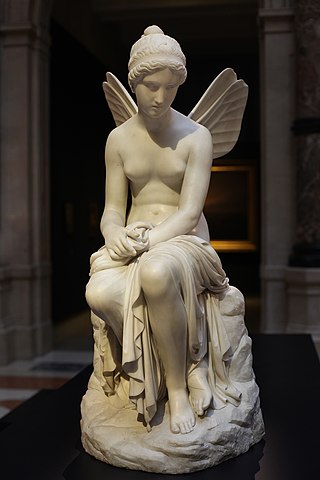
Psyche is the Greek goddess of the soul and often represented as a beautiful woman with butterfly wings. The name Psyche means "soul" in Greek and was commonly referred to as such in Roman mythology as well, though direct translation is Anima. She was born a mortal woman eventually granted immortality, with beauty that rivaled even Aphrodite, goddess of love. Psyche is known from the novel called The Golden Ass, also known as Metamorphoses, written by the Roman philosopher and orator Apuleius in the 2nd century. In the myth, she was given multiple trials in order to be with her beloved, Eros, also known as Cupid, god of physical love and desire and son of Aphrodite. The cultural influences of Psyche's story can be depicted in art dating back to the 4th century BCE.

In art history, the French term objet d’art describes an ornamental work of art, and the term objets d’art describes a range of works of art, usually small and three-dimensional, made of high-quality materials, and a finely-rendered finish that emphasises the aesthetics of the artefact. Artists create and produce objets d’art in the fields of the decorative arts and metalwork, porcelain and vitreous enamel; figurines, plaquettes, and engraved gems; ivory carvings and semi-precious hardstone carvings; tapestries, antiques, and antiquities; and books with fine bookbinding.

James Tassie (1735–1799) was a Scottish gem engraver and modeller. He is remembered for a particular style of miniature medallion heads, portraying the profiles of the rich and famous of Britain, and for making and selling large numbers of "Tassie casts" of engraved gems for collectors.

The Capitoline Museums are a group of art and archaeological museums in Piazza del Campidoglio, on top of the Capitoline Hill in Rome, Italy. The historic seats of the museums are Palazzo dei Conservatori and Palazzo Nuovo, facing on the central trapezoidal piazza in a plan conceived by Michelangelo in 1536 and executed over a period of more than 400 years.
Sir John Boardman, is a classical archaeologist and art historian. He has been described as "Britain's most distinguished historian of ancient Greek art."
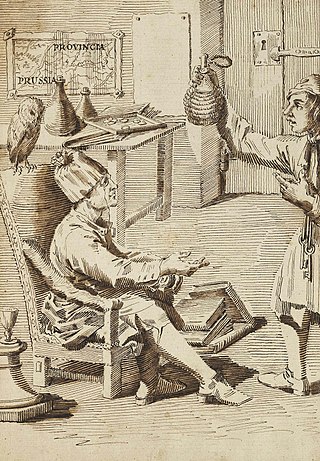
Baron Philipp von Stosch or Philippe de Stosch etc. was a Prussian antiquarian who lived in Rome and Florence.

The BnF Museum or Museum of the Bibliothèque nationale de France, formerly known as the Cabinet des Médailles, is a significant art and history museum in Paris. It displays collections of the Département des Monnaies, Médailles et Antiques de la Bibliothèque nationale de France as well as manuscripts and books from the Library's collections. The BnF Museum is located in the Richelieu site, the former main building of the library bordering rue de Richelieu.
The Marlborough gems were a large collection of jewels assembled by several Dukes of Marlborough. The collection was composed of more than 730 carved gemstones, including garnets, sapphires, emeralds and many cameos. The most famous cameo, and the Duke's favourite, was 'The Marriage of Cupid and Psyche'. A comprehensive catalogue was published in 1870 by Nevil Story Maskelyne. He made impressions and electrotypes, now in the Beazley Archive in Oxford, which have been published.

The Cup of the Ptolemies, also known as the Cup of Saint Denis, is an onyx cameo two-handled cup, or kantharos. The cup, decorated with Dionysiac vignettes and emblems, was carved at some point in Classical Antiquity, probably in Alexandria. Eventually, it found its way into the treasury of the French kingdom, before it was donated to the abbey of St. Denis. During the Middle Ages, it was used as a Christian chalice, and lavish mounts were added, with Latin inscriptions. In 1804, the cup was stolen, and the mounts were lost, although the cup itself was recovered. It is now in the Cabinet des Médailles at the Bibliothèque nationale de France, Paris.
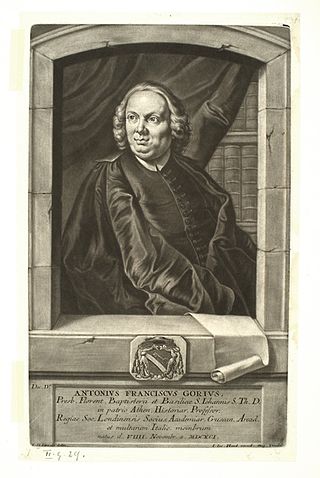
Antonio Francesco Gori, on his titlepages Franciscus Gorius, was an Italian antiquarian, a priest in minor orders, provost of the Baptistery of San Giovanni from 1746, and a professor at the Liceo, whose numerous publications of ancient Roman sculpture and antiquities formed part of the repertory on which 18th-century scholarship as well as the artistic movement of neoclassicism were based. In 1735 he was a founding member of a circle of antiquaries and connoisseurs in Florence called the Società Colombaria, the predecessor of the Accademia Toscana di Scienze e Lettere la Colombaria, to foster "not only Tuscan Poetry and Eloquence, or one faculty only; but almost all the most distinguished and useful parts of human knowledge: in a word, it is what the Greeks called Encyclopedia".

In classical mythology, Cupid is the god of desire, erotic love, attraction and affection. He is often portrayed as the son of the love goddess Venus and the god of war Mars. He is also known as Amor. His Greek counterpart is Eros. Although Eros is generally portrayed as a slender winged youth in Classical Greek art, during the Hellenistic period, he was increasingly portrayed as a chubby boy. During this time, his iconography acquired the bow and arrow that represent his source of power: a person, or even a deity, who is shot by Cupid's arrow is filled with uncontrollable desire. In myths, Cupid is a minor character who serves mostly to set the plot in motion. He is a main character only in the tale of Cupid and Psyche, when wounded by his own weapons, he experiences the ordeal of love. Although other extended stories are not told about him, his tradition is rich in poetic themes and visual scenarios, such as "Love conquers all" and the retaliatory punishment or torture of Cupid.
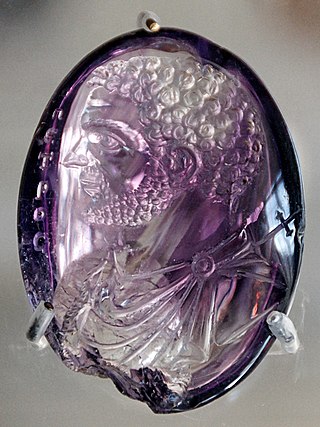
An engraved gem, frequently referred to as an intaglio, is a small and usually semi-precious gemstone that has been carved, in the Western tradition normally with images or inscriptions only on one face. The engraving of gemstones was a major luxury art form in the Ancient world, and an important one in some later periods.

Hardstone carving, in art history and archaeology, is the artistic carving of semi-precious stones, such as jade, rock crystal, agate, onyx, jasper, serpentinite, or carnelian, and for objects made in this way. Normally the objects are small, and the category overlaps with both jewellery and sculpture. Hardstone carving is sometimes referred to by the Italian term pietre dure; however, pietra dura is the common term used for stone inlay work, which causes some confusion.
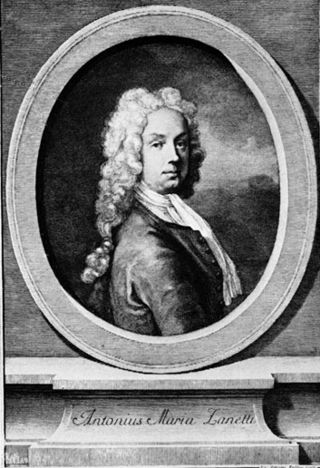
Count Anton[io] Maria Zanetti (1689–1767) was a Venetian artist, engraver, art critic, art dealer and connoisseur. He formed a collection of engraved gems, of which he published a lavish catalogue.
Marcantonio Sab[b]atini (1637–1724), of a noble family of Bologna, was an antiquary and papal curator to Pope Clement XI and art advisor to Charles VI, a central figure among the cognoscenti in Baroque Rome. Under his supervision the pope's nephew, Alessandro Albani, developed the taste for antiquities for which he is remembered; it was Sabbatini who selected from Albani's collection the antique moss agate carved in high relief with a sleeping tiger that would make a suitable gift to Prince Eugene of Savoy. Among carved gems the "Strozzi Medusa" bearing a signature "Solon" passed through Sabatini's collection. Carved gems in his collection were included among those in Paolo Alessandro Maffei's Gemme antiche, 1708; one of them, a head of Vespasian bears the added inscription LAUR. MED. of Lorenzo de' Medici, which was a habit of Lorenzo's.
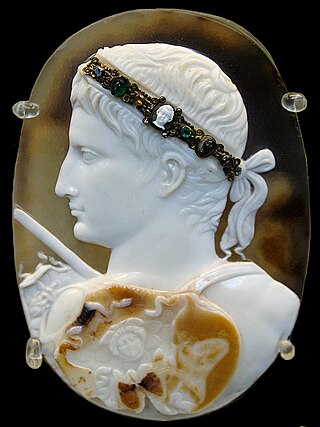
The Blacas Cameo is an unusually large Ancient Roman cameo, 12.8 cm (5.0 in) high, carved from a piece of sardonyx with four alternating layers of white and brown. It shows the profile head of the Roman emperor Augustus and probably dates from shortly after his death in AD 14, perhaps from AD 20–50. It has been in the British Museum since 1867, when the museum acquired the famous collection of antiquities that Louis, Duke of Blacas had inherited from his father, also including the Esquiline Treasure. Normally it is on display in Room 70.

Johann Lorenz Natter (1705–1763) was a German gem-engraver and medallist.

















